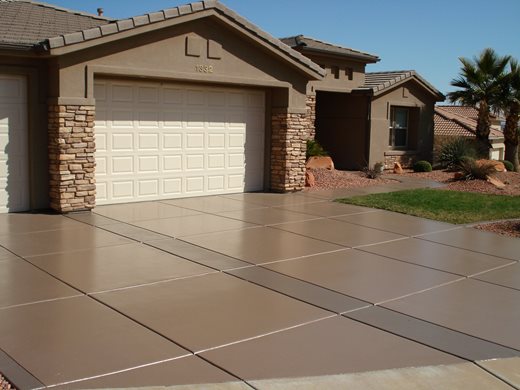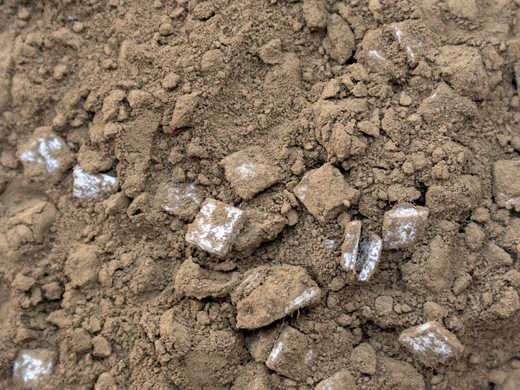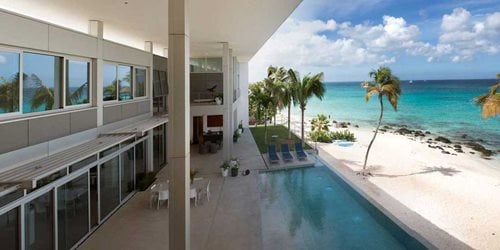Learn why fiber reinforced concrete is ideal for decorative work, and how UltraFiber 500® delivers the performance and finish contractors expect.
Posted 4/4/2025
Fiber reinforced concrete improves durability and helps control cracking, making it a smart addition to decorative and architectural projects. In the sections below, you'll learn how fiber works, what to look for in a fiber for decorative use, and why UltraFiber 500® is trusted by contractors for high-performance results without compromising the finish.


Fiber reinforced concrete is different from standard concrete because the mix includes small fibers that improve durability and reduce cracking. These fibers act as a secondary reinforcement—helping control shrinkage cracks and increasing the overall toughness of the slab.
While fiber won’t prevent all cracks, it helps reduce the size and frequency of plastic shrinkage cracks—the cracks that form early when the surface dries out faster than the slab below. By holding moisture in the slab longer, fibers promote a slower, more consistent cure. That added protection makes fiber reinforced concrete a smart choice for architectural and decorative projects, where both performance and appearance matter.
There are various types of fibers used to reinforce concrete:
Not all fibers are ideal for decorative concrete. Many synthetic fibers can float to the surface, creating a fuzzy finish or interfering with color and texture. For architectural work where appearance matters, that’s a dealbreaker.
To get the benefits of fiber—crack control, durability, and even freeze/thaw resistance—you need one that stays invisible in the mix and plays nicely with stamps, stains, and color.
The right fiber won’t change how the surface looks, but it will make a big difference in how it performs.

Would you believe this colored concrete has fiber in it? UltraFiber 500 doesn't leave unsightly hairs or fuzz in the concrete. Yet it offers superior shrinkage crack control.

Ultra-M1x combines color and fiber in one preblended bag for stronger, more beautiful concrete.
When it comes to decorative and architectural concrete, UltraFiber 500® stands out as the fiber that delivers durability without compromising appearance. Made from refined cellulose, it disperses evenly throughout the mix and stays completely invisible at the surface—no fuzz, no fiber balls, no interference with color or texture. Its specific gravity, which is close to that of concrete, helps keep the fibers suspended and evenly distributed.
It’s trusted by contractors for everything from stamped concrete patios to polished interior floors and architectural precast. Because it works below the surface, it allows your design work to shine—while providing added protection against cracking, freeze/thaw damage, and surface wear.
💡 Pro Tip: For even better control of moisture loss, pair UltraFiber 500® with DAY1® finishing aid.
UltraFiber 500 uses natural fibers and is derived from renewable resources, making it more sustainable than synthetic fibers. In fact, 100% of the cellulose fiber used in UltraFiber 500 is sourced from sustainably managed forests, where every tree harvested is replaced with several more.
“After discovering UltraFiber 500, we were so pleased with how it performed that we now use it in virtually every application. It makes a better structural product, a more beautiful cosmetic product, and we don’t have any of the problems we used to experience with synthetic fibers.”
— Kevin Baltz, Baltz & Sons Concrete
UltraFiber 500 isn’t just field-proven—it’s lab-tested. In side-by-side evaluations, concrete reinforced with UltraFiber 500 showed measurable improvements in durability, moisture resistance, and surface performance.
Key Results from Laboratory Testing:
These results confirm what contractors see in the field: UltraFiber 500 helps create longer-lasting, better-looking decorative concrete.
📄 View the full UltraFiber 500 test report (PDF)
“We’ve been using the UltraFiber 500 for about two years now on our decks, and we’ve had zero callbacks. The color is more consistent, and we’ve had no problems again with any of the colors we’ve used. I’ve had no structural issues on any jobs that we’ve done.”
— Jason Brownlee, landscape architect
| Feature | UltraFiber 500® | Synthetic Fibers |
|---|---|---|
| Surface visibility | Invisible when properly mixed | Often visible (fuzz or fiber balls) |
| Color compatibility | Excellent – accepts integral color, stains, and dyes | Can disrupt coloring or create uneven tones |
| Durability benefits | Controls cracking, reduces absorption, improves abrasion resistance | Controls cracking but offers limited surface benefits |
| Freeze/thaw protection | Proven improvement in lab testing | Varies by product, often untested |
| Sustainability | Made from renewable cellulose | Petroleum-based |
| Application suitability | Ideal for stamped, polished, and architectural work | Not recommended for decorative finishes |
Yes, you can mix both integral color and fiber into a concrete mix at the same time, enhancing both durability and appearance. UltraFiber 500 accepts color better than other fibers because it is hydrophilic—meaning it absorbs water and pigment instead of repelling them like polypropylene fibers. Contractors can use it with integral color to create vibrant, uniform hues. UltraFiber 500 is also compatible with stains and dyes.
💡 Pro Tip: For added convenience, try Brickform Ultra-M1x, a premixed solution that combines UltraFiber 500 and integral color in one bag. It’s easy to add at the batch plant or on-site and ensures consistent distribution throughout the mix.
Stamping concrete with fiber can be tricky. Some synthetic fibers rise to the surface, affecting the release process or leaving behind fuzz. UltraFiber 500® is different—it does not impact releasability or stamping detail. It stays below the surface, allowing for clean, detailed impressions. You can use either dry or liquid release agents to make the stamping process easier and ensure a clean release.
Not all fibers are suitable for polished concrete. Some synthetic fibers leave visible strands or create a fuzzy surface when ground and polished. But UltraFiber 500® stays evenly dispersed and invisible, even after polishing, so it won’t affect the clarity or appearance of the finished floors.
When a high-quality fiber is mixed properly, it isn’t visible in the concrete. However, if it isn’t mixed in enough, you may see clumps or areas where the fiber isn’t dispersed evenly. UltraFiber 500 is known for being invisible in the finished surface.
While fiber reinforced concrete strengthens the slab, it should not be used as a replacement for rebar. Rebar provides structural reinforcement for withstanding heavy loads and stress. Fiber should be used as secondary reinforcement.
Most fibers aren’t great for decorative concrete—many can rise to the surface or create a fuzzy texture that interferes with stamping or coloring. UltraFiber 500 is different. It adds durability and crack control without compromising appearance.

UltraFiber 500® is the only fiber on the market with a dedicated automated dispensing system. The UltraFiber Automated Dispenser accurately doses fiber directly into the mix—no manual handling required.
To get the best results with UltraFiber 500, it’s important to mix it properly. According to John Reynolds, Director of Training at Solomon Colors, “It’s not just about mixing long enough—it’s about having the right materials in the mix to help the fiber do its job.”
Reynolds recommends mixing for 12 to 15 minutes. This allows the fibers to fully separate and blend into the mix.
The shape of your aggregate impacts how well the fibers break apart.
Very fine materials like sand may not create enough friction or impact to break apart fiber clusters. Use mixes with small to mid-sized crushed stone for optimal results.
💡 Pro Tip: Always create a mockup before your final pour. This lets you confirm proper fiber dispersion, surface finish, and color consistency—especially important for decorative applications where appearance is everything.
UltraFiber 500® provides the strength, crack control, and long-term durability your projects need, all without affecting surface quality. Whether you’re working on stamped patios, polished floors, or architectural precast, it’s the fiber designed for decorative success.
It’s lab-tested, trusted by contractors, and fully compatible with integral color, stains, and finishing techniques. UltraFiber 500 is the clear choice for fiber reinforcement in architectural and decorative concrete.

Everything you need to know about adding color to concrete—from selection to installation and maintenance

People frequently ask how they can get stamped concrete over existing concrete. Tearing out and replacing concrete is costly and invasive.

Cool concrete isn't just neat. It's literally cool! Who hasn't had the experience of sprinting over a scorching hot concrete pool deck?
Explore impressive concrete installations to find inspiration for your next project.
Find out how much color and fiber you'll need for any size project.